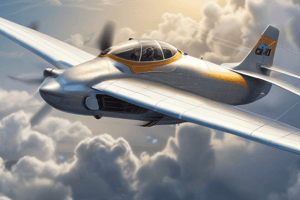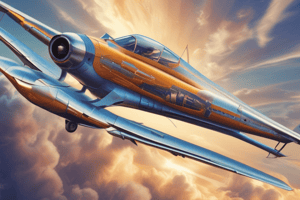Podcast
Questions and Answers
What is the main cause of wingtip vortices formation?
What is the main cause of wingtip vortices formation?
- The speed of the aircraft
- The difference in air pressure above and below the wing (correct)
- The angle of the aircraft's tail
- The shape of the aircraft wing
What is the direction of the rotation of the vortex?
What is the direction of the rotation of the vortex?
- It does not rotate
- Always clockwise
- Always counterclockwise
- Depends on the wing's angle of attack (correct)
How do wingtip vortices affect aircraft performance?
How do wingtip vortices affect aircraft performance?
- They have no effect on aircraft performance
- They increase lift and reduce drag
- They decrease lift and increase drag (correct)
- They only affect aircraft during takeoff
What is a potential hazard of wingtip vortices to other aircraft?
What is a potential hazard of wingtip vortices to other aircraft?
How can wingtip design help mitigate the effects of wingtip vortices?
How can wingtip design help mitigate the effects of wingtip vortices?
What is the purpose of increasing the distance between aircraft in relation to wingtip vortices?
What is the purpose of increasing the distance between aircraft in relation to wingtip vortices?
What is the role of air traffic control in relation to wingtip vortices?
What is the role of air traffic control in relation to wingtip vortices?
How far can wingtip vortices extend behind the aircraft?
How far can wingtip vortices extend behind the aircraft?
Flashcards are hidden until you start studying
Study Notes
Wingtip Vortices
Wingtip vortices are rotating air masses that form at the tip of an aircraft wing as it moves through the air.
Formation
- Created by the difference in air pressure above and below the wing
- As the wing produces lift, it deflects the air downward, creating a swirling motion
- The rotation of the air creates a vortex, which trails behind the wingtip
Characteristics
- Wingtip vortices are strongest at the tip of the wing and weaken as they move away from the aircraft
- They can extend several hundred feet behind the aircraft
- The rotation of the vortex can be clockwise or counterclockwise, depending on the wing's angle of attack
Effects on Aircraft
- Wingtip vortices can increase drag and reduce lift, resulting in decreased aircraft performance
- They can also cause turbulence and uneven airflow around the aircraft
- In some cases, wingtip vortices can cause aircraft to lose control or stall
Effects on Other Aircraft
- Wingtip vortices can pose a hazard to other aircraft, particularly during takeoff and landing
- They can cause turbulence and loss of control in trailing aircraft
- Aircraft are typically spaced at a safe distance to avoid encountering wingtip vortices
Mitigation Strategies
- Wingtip design: Wingtips can be designed to reduce vortex formation, such as through the use of raked wingtips or winglets
- Aircraft spacing: Increasing the distance between aircraft can reduce the risk of encountering wingtip vortices
- Air traffic control: Air traffic controllers can use spacing and sequencing to minimize the risk of wingtip vortex encounters
Wingtip Vortices
- Rotating air masses that form at the tip of an aircraft wing as it moves through the air
Formation
- Caused by the difference in air pressure above and below the wing
- Deflection of air downward by the wing creates a swirling motion, resulting in a vortex
Characteristics
- Strongest at the tip of the wing, weakening as they move away from the aircraft
- Can extend several hundred feet behind the aircraft
- Rotation can be clockwise or counterclockwise, depending on the wing's angle of attack
Effects on Aircraft
- Increase drag and reduce lift, resulting in decreased aircraft performance
- Cause turbulence and uneven airflow around the aircraft
- Can cause aircraft to lose control or stall
Effects on Other Aircraft
- Pose a hazard to other aircraft, particularly during takeoff and landing
- Can cause turbulence and loss of control in trailing aircraft
Mitigation Strategies
- Wingtip design: Raked wingtips or winglets can reduce vortex formation
- Aircraft spacing: Increasing the distance between aircraft reduces the risk of encountering wingtip vortices
- Air traffic control: Spacing and sequencing can minimize the risk of wingtip vortex encounters
Studying That Suits You
Use AI to generate personalized quizzes and flashcards to suit your learning preferences.




